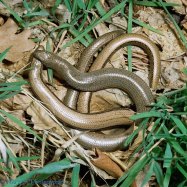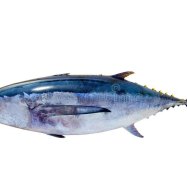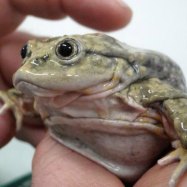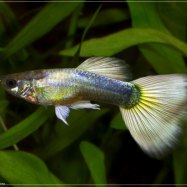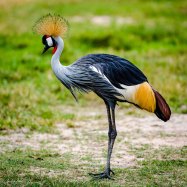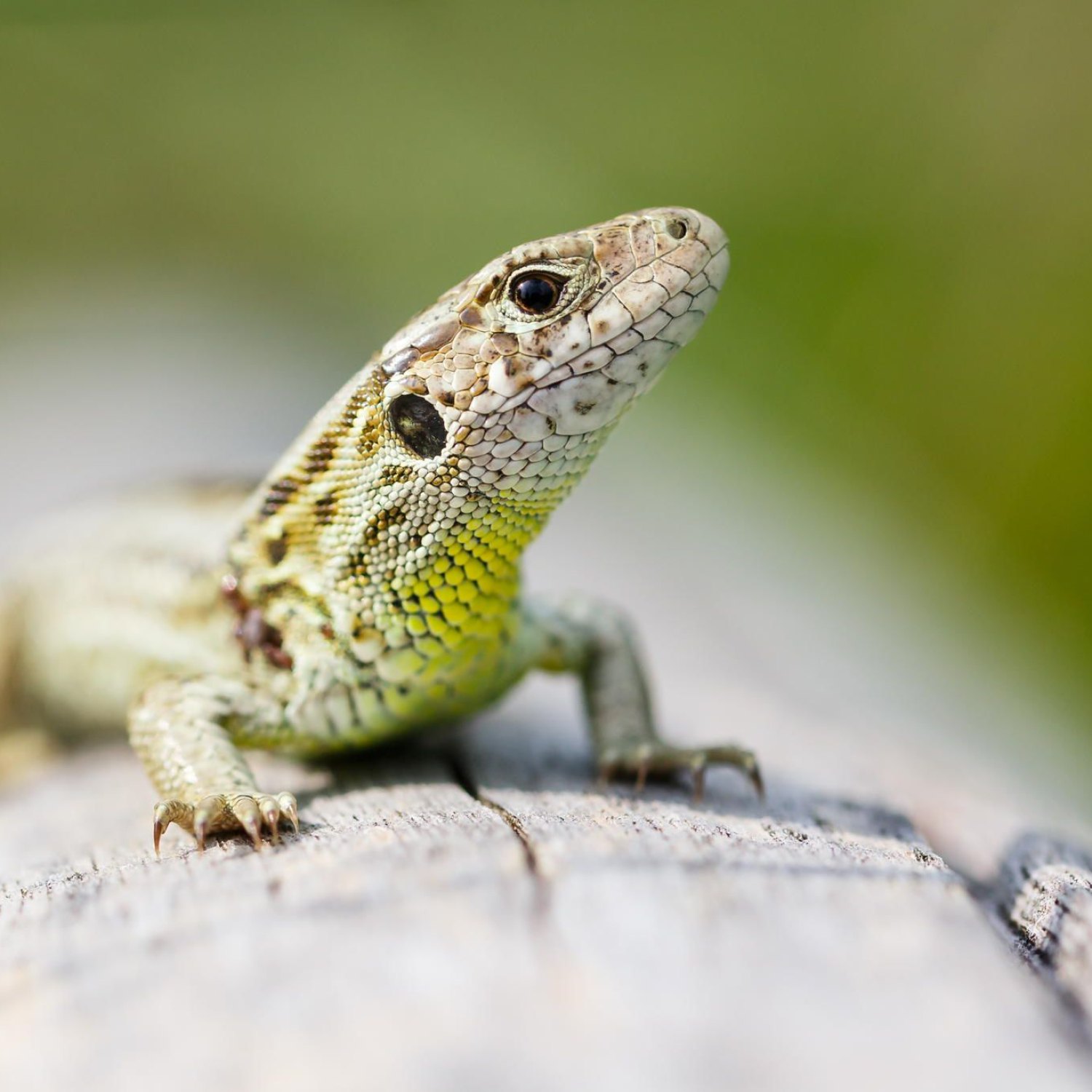
Sand Lizard
22-30 centimeters
The Sand Lizard, found in Europe, is a slender and agile reptile with a length of 22-30cm. Belonging to the family Lacertidae, it is commonly found in sandy habitats and feeds on insects. Its distinct coloration makes it a popular sight for nature enthusiasts. #SandLizard #EuropeanReptiles #Lacertidae
Animal Details Summary:
Common Name: Sand Lizard
Kingdom: Animalia
Habitat: Grasslands, heathlands, dunes, and coastal areas
Uncovering the Unique Features of the Sand Lizard
Have you ever taken a walk through a sandy coastal area or a grassy field and noticed a small and agile creature darting around? If so, there's a high chance that you may have caught a glimpse of the Sand Lizard, also known as Lacerta agilis.This little reptile may be small in size, but it has some interesting features that make it stand out among other animals. In this article, we'll take a closer look at the unique characteristics of the Sand Lizard, from its habitat and feeding habits to its physical appearance and geographical distribution.
Habitat and Distribution
The Sand Lizard is native to Europe, specifically found in central and southern parts of the continent Sand Lizard. It can be spotted in various countries including Germany, France, Poland, and Ukraine, among others. Due to its wide distribution, it is also commonly known as the European Sand Lizard.But what makes this little reptile thrive in these regions? The Sand Lizard is a hardy creature, able to adapt to different landscapes and habitats. It can be found in grasslands, heathlands, dunes, and coastal areas. This flexibility in habitat allows the Sand Lizard to flourish and thrive in different environments.
Feeding Habits
Like most reptiles, the Sand Lizard is an insectivore, meaning it solely feeds on insects. They have a particular preference for beetles, ants, and spiders, which they capture with their quick reflexes and agile movements.Their diet plays a crucial role in their ecosystem as they help control the insect population. With their high demand for insects, Sand Lizards can also be indicators of a healthy insect population within their habitat Sculpin.
Physical Appearance
The Sand Lizard's scientific name, Lacerta agilis, translates to "nimble lizard." And it's no wonder as this little creature's body is slender and agile. Their slender body shape allows them to move quickly and swiftly, making them skilled hunters and excellent at avoiding predators.In terms of coloration, male Sand Lizards are unique with a bright green color and dark spots, making them easy to spot in a sandy or grassy environment. Their colors also intensify during the breeding season, making them even more visually striking. On the other hand, females have a more subdued brown color with darker bands on their back.
This color difference between males and females is known as sexual dimorphism, a common characteristic in reptiles. It helps with species recognition and can also play a role in mating behavior.
Geographical Distribution
As mentioned earlier, the Sand Lizard is found in various countries in Europe. But interestingly, the geographical distribution of this reptile is not limited to Europe alone. Some isolated populations have also been found in Turkey and Iran, indicating that these lizards have a wide range of geographical distribution.This adaptability to different landscapes and climates is one of the reasons why the Sand Lizard has been able to thrive in different regions.
Conservation Status
While the Sand Lizard may have a wide distribution, it doesn't mean it is not facing any threats. Like many other reptiles, the Sand Lizard is susceptible to habitat loss due to human activities such as urbanization and agriculture.In some regions, this species is also facing a decline in population due to human persecution and road mortality. But there is still hope for the Sand Lizard, as it is listed as least concern on the IUCN Red List, meaning it is not currently at risk of extinction. Nevertheless, conservation efforts are still needed to ensure the continued survival of this unique reptile.
Fun Facts about the Sand Lizard
- During the breeding season, male Sand Lizards develop bright blue spots on their throats, which they use to attract females.- Sand Lizards are diurnal, meaning they are active during the day and sleep at night.
- They are excellent climbers, using their sharp and curved claws to maneuver and balance on trees and rocks.
- These lizards have a lifespan of up to 10 years in the wild.
The Significance of the Sand Lizard
Apart from being an indicator of a healthy ecosystem, the Sand Lizard also plays a vital role in maintaining the balance of the food chain. As insectivores, they help control the population of insects, which can otherwise cause negative effects on plant growth and other animal species.They are also crucial in the food chain as prey for various predators, including birds, snakes, and mammals. Losing this species can have a trickle-down effect on the entire ecosystem.
Conclusion
In reference to its scientific name, Lacerta agilis, the Sand Lizard is indeed a nimble creature, with its ability to adapt to different habitats, agile movements, and quick reflexes. Its unique physical features, geographical distribution, and feeding habits make it a fascinating reptile to learn about.But above all, the Sand Lizard serves as a reminder of the importance of preserving and protecting our natural environment. As humans, it is our responsibility to make sure that these fascinating creatures continue to thrive in their natural habitats for generations to come. So, the next time you come across a Sand Lizard, take a moment to appreciate its beauty and the role it plays in our ecosystem.

Sand Lizard
Animal Details Sand Lizard - Scientific Name: Lacerta agilis
- Category: Animals S
- Scientific Name: Lacerta agilis
- Common Name: Sand Lizard
- Kingdom: Animalia
- Phylum: Chordata
- Class: Reptilia
- Order: Squamata
- Family: Lacertidae
- Habitat: Grasslands, heathlands, dunes, and coastal areas
- Feeding Method: Insectivorous
- Geographical Distribution: Central and southern Europe
- Country of Origin: Multiple countries in Europe
- Location: Europe
- Animal Coloration: Males have green coloration with dark spots, females are brown with darker bands on the back
- Body Shape: Slender and agile
- Length: 22-30 centimeters
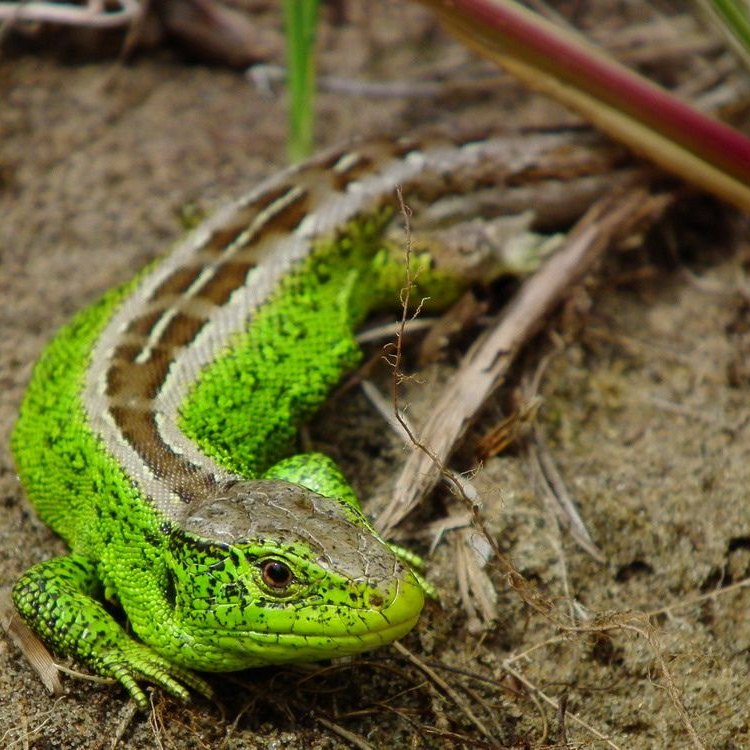
Sand Lizard
- Adult Size: Around 30 centimeters
- Average Lifespan: 8-15 years
- Reproduction: Oviparous (lays eggs)
- Reproductive Behavior: Mating season occurs in spring and the female lays 8-20 eggs in June or July
- Sound or Call: Males produce a series of clicks during courtship displays
- Migration Pattern: Non-migratory
- Social Groups: Solitary
- Behavior: Active during the day, basks in the sun to regulate body temperature
- Threats: Habitat loss, fragmentation, and degradation
- Conservation Status: Least Concern
- Impact on Ecosystem: Important in maintaining ecosystem balance by controlling insect populations
- Human Use: Some populations are used for scientific research
- Distinctive Features: Distinct coloration and pattern with males having bright green coloration
- Interesting Facts: The sand lizard is one of only three native reptile species in the UK
- Predator: Birds of prey, snakes, and mammals
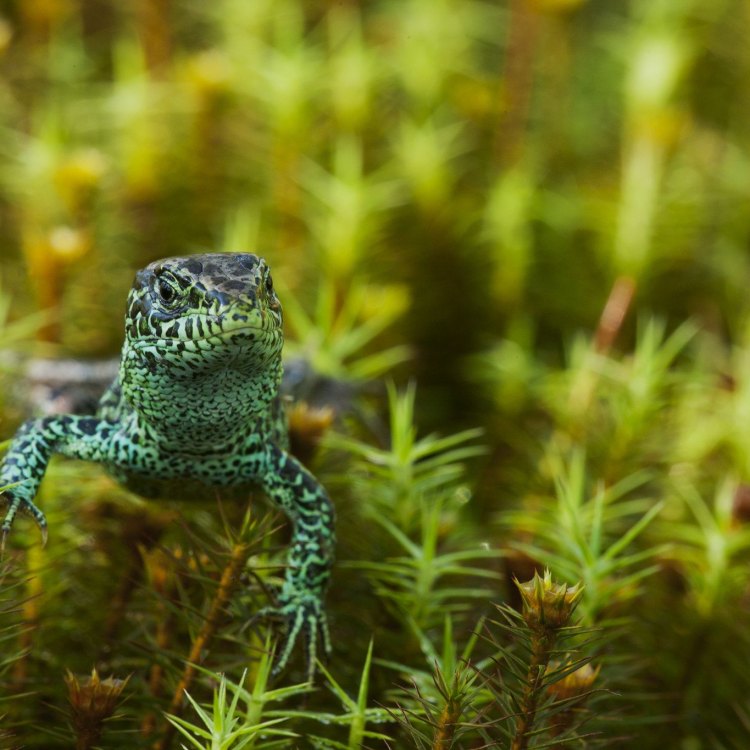
Lacerta agilis
The Unique Features of the Fascinating Sand Lizard
The world is full of fascinating creatures, each with their own unique features and behaviors. One such captivating creature is the sand lizard, a small reptile found in various parts of Europe and the UK. Despite its plain name, the sand lizard holds many distinctive characteristics that set it apart from other lizards and make it a valuable member of its ecosystem. In this article, we will delve into the world of sand lizards, exploring their physical features, behaviors, and role in the environment PeaceOfAnimals.Com.Adult Size and Lifespan
First and foremost, let's talk about the size and lifespan of the sand lizard. On average, these lizards reach a length of around 30 centimeters, making them one of the smaller species of lizards. However, do not let their size deceive you, as they possess a big personality and unique features that make them stand out.
In terms of lifespan, sand lizards can live between 8 to 15 years in the wild. Of course, this can vary depending on their habitat and any potential threats they may face. These lizards reach sexual maturity at around three years old, with females having a shorter lifespan compared to males.
Reproduction and Behavior
Now, let's dive into the reproductive behavior of the sand lizard, which is fascinating in itself. These lizards are oviparous, meaning they reproduce by laying eggs. The mating season for sand lizards occurs in the spring, and females will lay 8-20 eggs in June or July Sea Roach. The female will bury her eggs in the sand or soil, where they will hatch after two to three months.
But what about their reproductive behavior? During the mating season, male sand lizards produce a series of clicks as part of their courtship displays to attract females. This unique behavior is not only used for mating but also serves as a way for males to establish their territory.
Social Groups and Migration Pattern
One of the more interesting facts about sand lizards is that they are solitary creatures, meaning they do not live in large social groups. Each lizard will have its own territory, which is used for basking and foraging. This aspect of their behavior makes them an intriguing species, as they do not rely on others for survival.
Additionally, sand lizards are non-migratory, meaning they do not undergo seasonal movements. They stay in their designated territory throughout the year, basking in the sun and regulating their body temperature.
Distinctive Features
One of the most noticeable things about the sand lizard is its distinctive coloration and pattern. These lizards have a grey or brown base color, with black spots adorning their bodies. However, it is the males who have the most striking feature - a bright green coloration on their bodies during the breeding season, making them stand out among other lizards.
This unique coloration serves a purpose, as it is used to attract potential mates during the mating season. It is also believed that the brighter the male's green coloration, the more desirable he is to females. This interesting fact about their distinctive features is just one of the many elements that make sand lizards so fascinating to observe and study.
Interesting Facts
The intriguing nature of the sand lizard doesn't stop at their coloration and behavior. One of the most interesting facts about these lizards is that they are one of only three native reptile species in the UK. The other two species are the common lizard and the slow worm. This makes the sand lizard a unique and valuable species to the UK ecosystem.
Impact on Ecosystem
Speaking of the ecosystem, let's discuss the crucial role that sand lizards play. As with any living creature, these lizards have an impact on their environment. They are important in maintaining ecosystem balance by controlling insect populations, as they are voracious predators of insects. This means they are essential in controlling insect populations, which, if left unchecked, could have harmful effects on the ecosystem.
Threats and Conservation Status
Unfortunately, like many other species, sand lizards face threats to their existence. One of the main threats is habitat loss, fragmentation, and degradation, primarily due to human activities such as urban development and agriculture. As these lizards are solitary creatures, they require a specific type of habitat, and any disruption to their environment can have devastating consequences.
However, there is some good news. According to the International Union for Conservation of Nature (IUCN), the sand lizard is currently listed as Least Concern on the conservation status list. This is due to their wide distribution across Europe and the UK, as well as ongoing conservation efforts to protect and preserve their habitats.
Human Use
Apart from their significant role in the environment, sand lizards also have some use for humans. Some populations are used for scientific research, particularly in studying their behavior and reproductive patterns. This research helps us gain a better understanding of these fascinating creatures and how we can work towards their conservation.
Predators
Like many other small animals, sand lizards face threats from predators. Birds of prey, snakes, and mammals are among the top predators of these lizards. The sand lizard's small size and solitary nature make them vulnerable to attacks, but they have developed certain behaviors, such as hiding and camouflage, to protect themselves from potential danger.
Conclusion
In conclusion, it is evident that the sand lizard is truly a unique and fascinating creature. From their distinctive coloration to their reproductive behavior and role in the ecosystem, these lizards possess many interesting features that set them apart from other lizards. While they may face threats to their existence, conservation efforts and their current Least Concern status give us hope for their future. As we continue to learn more about these captivating creatures, it is crucial to appreciate and protect them for generations to come.
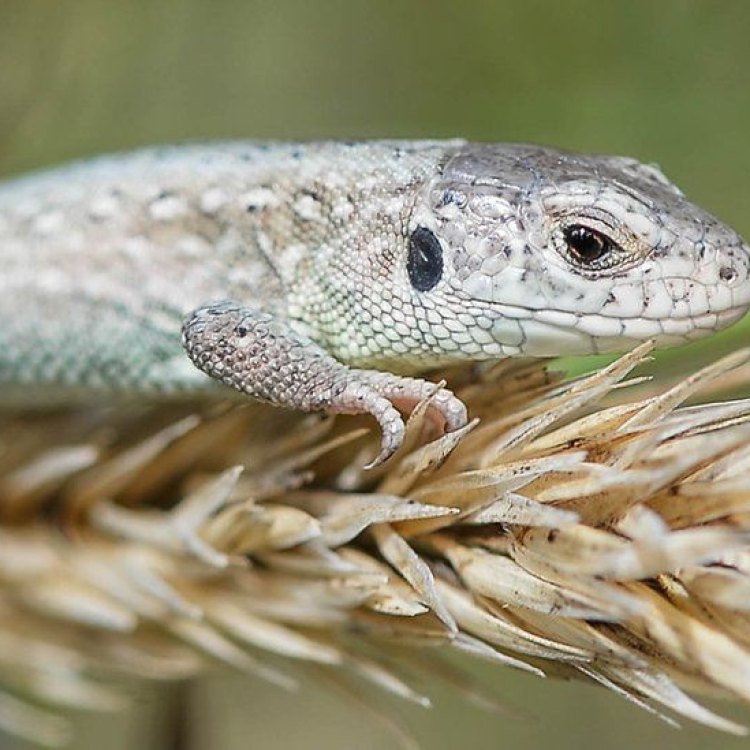
Uncovering the Unique Features of the Sand Lizard
Disclaimer: The content provided is for informational purposes only. We cannot guarantee the accuracy of the information on this page 100%. All information provided here may change without prior notice.



